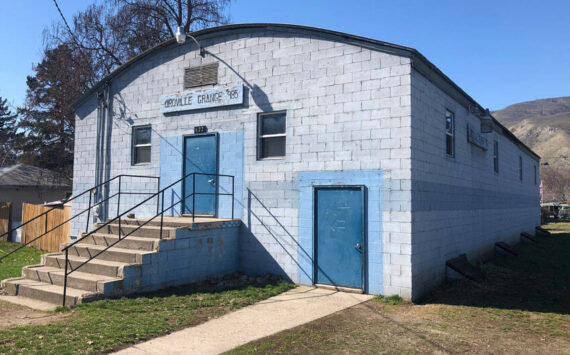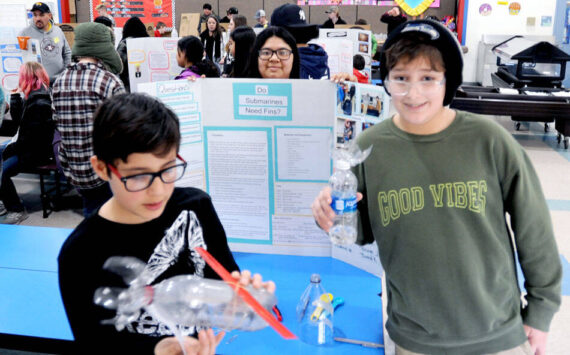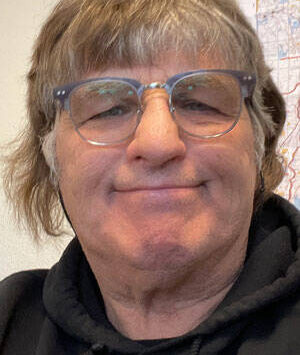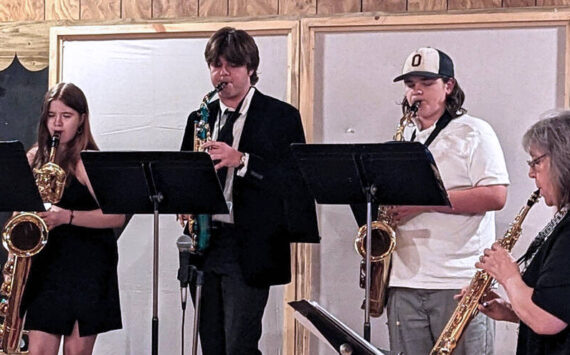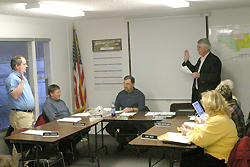

Photo by Gary DeVon Tim Whiteaker, the newest school director on the Oroville School Board was sworn in at the board’s Monday, Jan. 28 meeting. Whiteaker, who was sworn in by Superintendent Ernie Bartelson, works as an electrician and is in charge of ma
Editor’s Note: This week we hear from Oroville School District Superintendent Ernie Bartelson and Business Manager Shay Shaw on a few of the reasons the school board felt it necessary to increase the M & O Levy and in turn the levy rate. Next week we’ll look at some of the other factors for the increase and hear from board members themselves. G.A.D.
By Gary A. DeVon
Managing Editor
OROVILLE – At their Jan. 14 meeting the Oroville School Board approved a special two-year $771,000 maintenance and operations levy to be placed before the voters on March 11.
Although the levy represents an increase in both the amount and the rate, the school board felt the increase was justified to cover increasing costs that could lead to a critical fiscal situation within the district.
During a levy workshop the previous Monday, Superintendent Ernie Bartelson
and District Business Manager Shay Shaw presented budget information including the maintenance and operation issues that are facing critical shortages in funding for the 2008-2010 school years.
According to Bartelson and Shaw, the preliminary goal for the upcoming levy was to keep the levy at its current rate of $1.99/$1000 of assessed valuation.
“Between 1997 and 2006, a ten-year span, we were able to keep our levy amount and the rate nearly the same each year,” said Bartelson. “In 2006, however, we just couldn’t hold it another year. Inflation, new programs and legislative mandates drove the amount up and our rate increased from $1.84 to $1.99.
“Shay Shaw tried everything she could to keep that $1.99 rate again for the next two years but, again, inflation, more mandates and a couple of unforeseen items required the board to increase the rate 23 cents to $2.22 per $1000 of assessed valuation,” said the superintendent.
“My job as the fiscal officer for our district is to leave no stone uncovered and no funding source untapped to bring in the absolute maximum amount of money available to our district from every funding source available to schools from the state and federal governments,” said Shaw “We have been able to remain one or the best deals in education in terms of funding our schools because everyone helps to keep the amount and rate down.”
The business office and superintendent’s office, as well as building staff write grants to get free funding from state and federal agencies. In the past years they have generated over $1 million a year just through their grant writing efforts, according to Shaw.
“Those dollars go directly to kids and programs,” she said.
The levy amount set by the board for the March 11 ballot will be $771,000 and collected in 2009 and 2010. That amount will require a 23 cents increase in the levy rate to $2.22 per $1000 in assessed property valuation. The current levy is $518,000 and is being collected at a rate of $1.99 per $1000 in assessed valuation.
Both Bartelson and Shaw see the increase in the amount as the result of an unforeseen utility error and required upgrades in textbooks, technology and basic education programs.
“Over the past five years we have fallen behind in our textbook adoption because of the enormous cost of texts today. Not too many years ago we were still paying $25 to $30 for a textbook. The cost for each textbook we purchase today, depending upon the subject matter, will be in the $75 to $100 plus range. At that price, it doesn’t take long to fall behind in purchases,” said Bartelson.
With the new state testing program and required textbook programs, the district doesn’t have a choice to purchase or not, according to the superintendent.
“If we want our kids to pass the WASL test we have to have the books that cover the material and relate to the test program. There are always more materials that go with those texts and training of staff to use the new programs. Staff training, new books and keeping up with the technology changes are going to require an additional $100,000 to the school’s curriculum budget,” he said.
One of the most difficult issues that faced the school district over the past 18 months was a notice from the local electric utility that an error was made during the high school remodeling in 1993.
“It was a sad day for all of us when we received notification from the PUD that the utility meters installed during the remodel were set incorrectly resulting in our paying only half of what we should have been paying over the past 15 years,” said Shaw. “The state only allows utilities to reclaim errors during the past three years, but that was still a lot of money… money that we had not budgeted.”
In the final analysis, the district’s utility bills on the corrected meters are costing between $80,000 and $100,000 more each year, according to Shaw.
“I’ve been able to transfer some money and take money from our emergency reserve account to cover this new cost, but those money sources have dried up and these new costs must be added to our levy,” she said.
While Oroville’s levy is $771,000 at a rate of $2.22, Bartelson asks district voters to compare the levy with Tonasket’s $784,000 levy at $2.22 and Pateros’ $395,000 at $2.33, Okanogan’s $599,000 at $2.49, Mansfield’s $125,000 at $2.58, Brewster’s $850,000 at $3.49, Omak’s $1,750,000 at $3.55 and Coulee Dam’s $806,000 at $4.75.
“Our district looks very good compared to our neighbors. Our levy rate is the lowest of eight neighboring districts and our levy amount is the lowest of the five largest districts,” he said.

